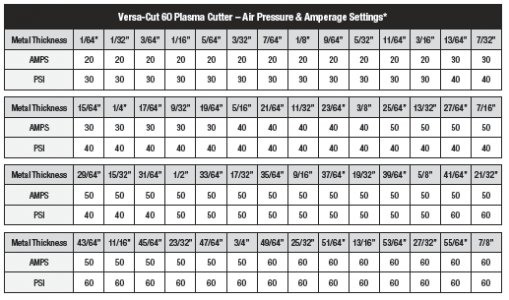- Joined
- Nov 23, 2014
- Messages
- 2,632
I’ve been watching on and off again the model ATPC54 50A plasma cutters continually sold on eBay by seller “dmssgs” out of Birmingham, MI. I have an oxyacetylene set up with a cutting torch but have wanted a plasma cutter for roughing out 16 gauge or thinner sheet steel for some projects. I upgraded my band saw from a 4 x 6 to a 7 x 12 and haven’t found any blades in the 20 – 24 tooth per inch range to use on sheet metal. The ATPC54 is rated at a maximum cut depth of ¾” with a 60% duty cycle. “dmssgs” warranties the unit for 1 year parts and labor.
Seller “dmssgs” lists these units twice a day every day, so there’s no shortage of supply. I tracked auctions for about a month and the units sold for between $230 on down to $145. I’m patient so I started bidding on units at a max bid of $160 and eventually won one. eBay item# 332023536205 is a typical listing if you are interested after reading this review; auctions start at $0.01.
Shipping was quick, packaging was excellent. The instruction manual is a misnomer, shows a picture of the finished set up of the machine but doesn’t give any recommended amp settings or air pressure settings for cutting various thicknesses of conductive material. Yes, the manual does say the plasma cutter will cut anything that conducts electricity and shows how the components of the torch go together, but that’s about it.
I believe the plasma cutting operation is much like an oxyacetylene cutting torch except instead of using oxygen and acetylene to generate heat, there is a DC arc from the torch to the material to be cut which is grounded to the unit. Instead of a blast of air from the oxyacetylene cutting torch to blow away the molten metal, the plasma cutter has a constant blast of regulated shop air.
The unit takes either 110V or 220V and self-recognizes the input voltage. It does not come with a power plug, so I picked up a 220V 50A plug from Menards for about $12. I also picked up a 50A female outlet for around $12 and a 110V male plug for $3 to make a 110V to 220V jumper harness to do some cutting where 220V isn’t available.
I did have a couple of minor problems with the unit as received. The unit has a regulator for varying air pressure and uses what I call a repair hose nipple to run air from the regulator to the unit. Regardless how tightly I turned the hose clamp, it leaked a fair amount of air. Swapped in a Milton ¼” repair nipple and the problem was solved. They supply a second repair nipple for connecting shop air to the regulator, but I swapped in a male quick connect.
The protective sleeve that runs from the unit to the torch is held to the torch handle with electrical tape. As received there were 3 or 4 wraps around the airline/wiring protective sleeve and the torch base which quickly separated. I peeled off the tape, slipped the protective sleeve up past the base of the handle and wrapped it again. The base of the torch handle is bigger than the main grip, so sliding the sleeve up past the torch base let me wrap the sleeve down tightly above the torch handle base so it won’t pull off the torch handle.
Another improvement could be a longer power cord which is only about 30” long. Maybe one of these days I’ll rewire it with a 10 ft. or so cord. Or better yet, make up a 220V extension cord which will work with my welders also.
So how does it work? No problems so far, photo shows me cutting through ¼” steel at 40A, air pressure around 40 psi. I have to admit to not doing any research on what my settings should be for ¼” steel, maybe I’m too high on the amps and too low on the air. Regardless, the cuts across the 3” wide piece of ¼” steel were made in about 20 seconds.
As always, you get what you pay for, so I’m crossing my fingers that the unit will last. It does have a 1 year parts and labor warranty; with the seller being only about 80 miles from me I took the risk. Harbor Freight sells a 220V-only plasma cutter with similar specs for $700 for a apples to apples comparison. No buyer’s remorse so far, very pleased with the unit!
Bruce
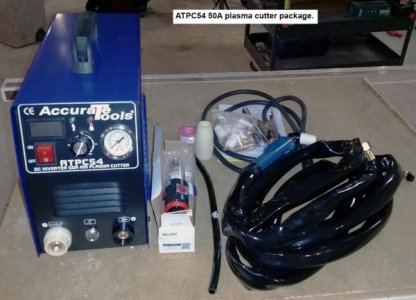
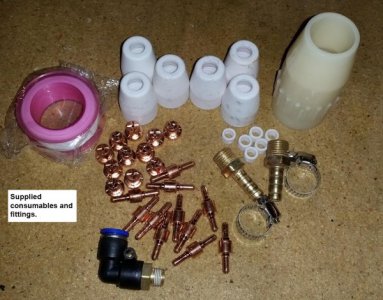
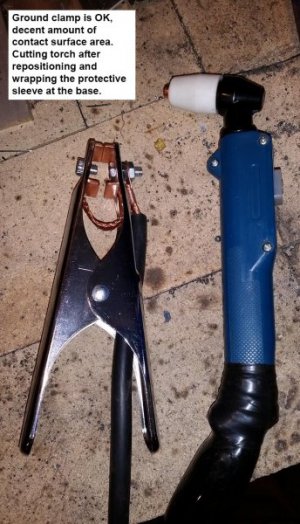
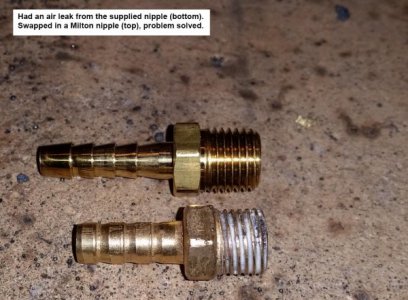
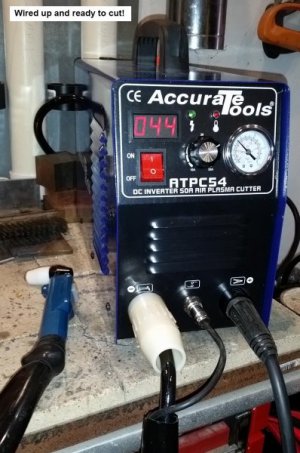
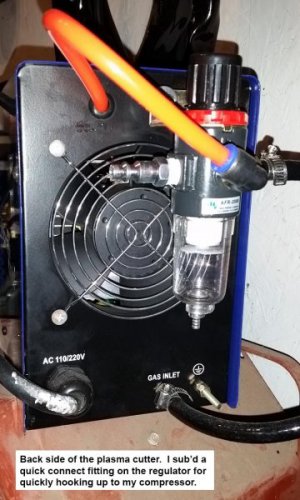
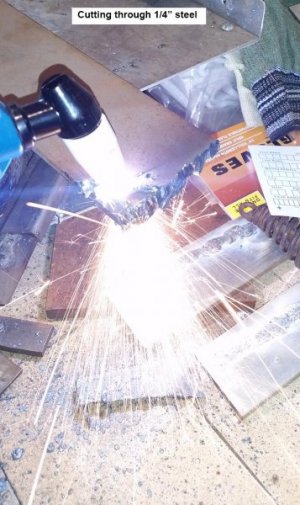
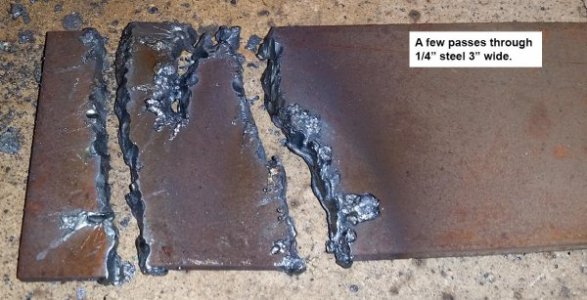
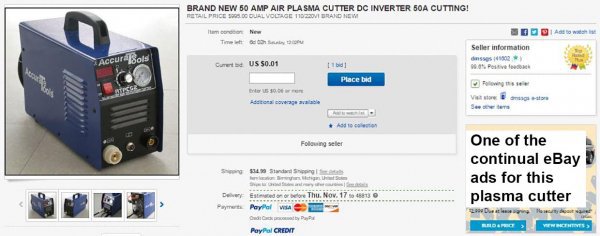
Seller “dmssgs” lists these units twice a day every day, so there’s no shortage of supply. I tracked auctions for about a month and the units sold for between $230 on down to $145. I’m patient so I started bidding on units at a max bid of $160 and eventually won one. eBay item# 332023536205 is a typical listing if you are interested after reading this review; auctions start at $0.01.
Shipping was quick, packaging was excellent. The instruction manual is a misnomer, shows a picture of the finished set up of the machine but doesn’t give any recommended amp settings or air pressure settings for cutting various thicknesses of conductive material. Yes, the manual does say the plasma cutter will cut anything that conducts electricity and shows how the components of the torch go together, but that’s about it.
I believe the plasma cutting operation is much like an oxyacetylene cutting torch except instead of using oxygen and acetylene to generate heat, there is a DC arc from the torch to the material to be cut which is grounded to the unit. Instead of a blast of air from the oxyacetylene cutting torch to blow away the molten metal, the plasma cutter has a constant blast of regulated shop air.
The unit takes either 110V or 220V and self-recognizes the input voltage. It does not come with a power plug, so I picked up a 220V 50A plug from Menards for about $12. I also picked up a 50A female outlet for around $12 and a 110V male plug for $3 to make a 110V to 220V jumper harness to do some cutting where 220V isn’t available.
I did have a couple of minor problems with the unit as received. The unit has a regulator for varying air pressure and uses what I call a repair hose nipple to run air from the regulator to the unit. Regardless how tightly I turned the hose clamp, it leaked a fair amount of air. Swapped in a Milton ¼” repair nipple and the problem was solved. They supply a second repair nipple for connecting shop air to the regulator, but I swapped in a male quick connect.
The protective sleeve that runs from the unit to the torch is held to the torch handle with electrical tape. As received there were 3 or 4 wraps around the airline/wiring protective sleeve and the torch base which quickly separated. I peeled off the tape, slipped the protective sleeve up past the base of the handle and wrapped it again. The base of the torch handle is bigger than the main grip, so sliding the sleeve up past the torch base let me wrap the sleeve down tightly above the torch handle base so it won’t pull off the torch handle.
Another improvement could be a longer power cord which is only about 30” long. Maybe one of these days I’ll rewire it with a 10 ft. or so cord. Or better yet, make up a 220V extension cord which will work with my welders also.
So how does it work? No problems so far, photo shows me cutting through ¼” steel at 40A, air pressure around 40 psi. I have to admit to not doing any research on what my settings should be for ¼” steel, maybe I’m too high on the amps and too low on the air. Regardless, the cuts across the 3” wide piece of ¼” steel were made in about 20 seconds.
As always, you get what you pay for, so I’m crossing my fingers that the unit will last. It does have a 1 year parts and labor warranty; with the seller being only about 80 miles from me I took the risk. Harbor Freight sells a 220V-only plasma cutter with similar specs for $700 for a apples to apples comparison. No buyer’s remorse so far, very pleased with the unit!
Bruce










